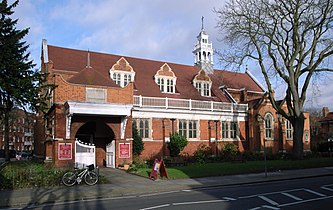
Chiswick is a district in the London Borough of Hounslow, West London, England. It contains Hogarth's House, the former residence of the 18th-century English artist William Hogarth; Chiswick House, a neo-Palladian villa regarded as one of the finest in England; and Fuller's Brewery, London's largest and oldest brewery. In a meander of the River Thames used for competitive and recreational rowing, with several rowing clubs on the river bank, the finishing post for the Boat Race is just downstream of Chiswick Bridge.

Blenheim Palace is a country house in Woodstock, Oxfordshire, England. It is the seat of the Dukes of Marlborough. Originally called Blenheim Castle, it has been known as Blenheim Palace since the 19th century. One of England's largest houses, it was built between 1705 and 1722, and designated a UNESCO World Heritage Site in 1987.

Woodstock is a market town and civil parish, 8 miles (13 km) north-west of Oxford in West Oxfordshire in the county of Oxfordshire, England. The 2021 census recorded a parish population of 3,521, up from the previous 3,100 in 2011.
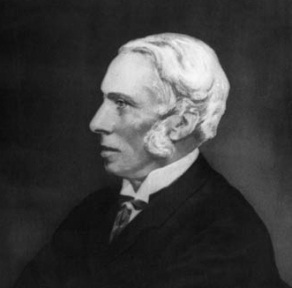
Richard Norman Shaw RA, also known as Norman Shaw, was a British architect who worked from the 1870s to the 1900s, known for his country houses and for commercial buildings. He is considered to be among the greatest of British architects; his influence on architectural style was strongest in the 1880s and 1890s.
Edward Hargitt was a Scottish ornithologist and landscape painter.

Arts Educational Schools, or ArtsEd, is an independent performing arts school in Chiswick, West London, England.

Edward John May (1853–1941) was an English architect.

The Tabard Theatre is a small 96-seat theatre in Chiswick in the London Borough of Hounslow. Close to Turnham Green Underground station, it is situated above the Tabard public house on Bath Road. The Tabard Theatre was licensed and opened for theatre use in 1985. It was renamed as the Chiswick Playhouse in 2019 which closed in March 2022. It is reopening as the Tabard in September 2022.
Acton Green is a residential neighbourhood in Chiswick and the London Borough of Ealing, in West London, England. It is named for the nearby Acton Green common. It was once home to many small laundries and was accordingly known as "Soapsuds Island".

The London Buddhist Vihara is one of the main Theravada Buddhist temples in the United Kingdom. The Vihara was the first Sri Lankan Buddhist monastery to be established outside Asia.
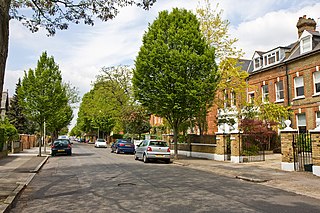
Grove Park is an area in the south of Chiswick, now in the borough of Hounslow, West London. It lies in the meander of the Thames occupied by Duke's Meadows park. Historically, the area belonged to one of the four historic villages in modern Chiswick, Little Sutton. It was long protected from building by the regular flooding of the low-lying land by the River Thames, remaining as orchards, open fields, and riverside marshland until the 1880s. Development was stimulated by the arrival of the railway in 1849; Grove Park Hotel followed in 1867, soon followed by housing.
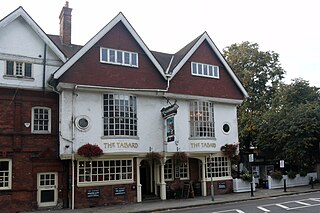
The block of three buildings containing The Tabard public house is a Grade II* listed structure in Chiswick, London. The block, with a row of seven gables in its roof, was designed by Norman Shaw in 1880 as part of the community focus of the Bedford Park garden suburb. The block contains the Bedford Park Stores, once a co-operative, and a house for the manager.

St Michael and All Angels is a Grade II* listed Church of England parish church in Bedford Park, Chiswick. It was designed by the architect Norman Shaw, who built some of the houses in that area. The church was consecrated in 1880. It is constructed in what has been described both as British Queen Anne Revival style and as Perpendicular Gothic style modified with English domestic features. Its services are Anglo-Catholic.

Jonathan Thomas Carr (1845–1915) was an English cloth merchant turned property developer and speculator. He is remembered for founding the Bedford Park garden suburb in Chiswick, west London. While he probably was not made bankrupt by that development, he later received a record-breaking 342 bankruptcy petitions.

Chiswick Mall is a waterfront street on the north bank of the river Thames in the oldest part of Chiswick in West London, with a row of large houses from the Georgian and Victorian eras overlooking the street on the north side, and their gardens on the other side of the street beside the river and Chiswick Eyot.

Tabard Gardens is a small park in Southwark, London. It is located on Tabard Street and gives its name to the surrounding Tabard Gardens Estate. The park was created as part of a slum clearance programme by the London County Council and opened in 1929. It is owned and managed by Southwark Council.
Thomas Erat Harrison (1858–1917) was an English artist who made sculptures, medals, paintings, and stained glass.
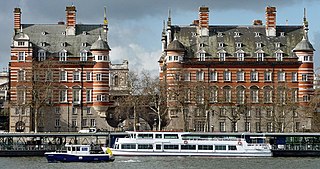
British Queen Anne Revival architecture, also known as Domestic Revival, is a style of building using red brick, white woodwork, and an eclectic mixture of decorative features, that became popular in the 1870s, both for houses and for larger buildings such as offices, hotels, and town halls. It was popularised by Norman Shaw (1831–1912) and George Devey (1820–1886).

The architecture of Bedford Park in Chiswick, West London, is characterised largely by Queen Anne Revival style, meaning an eclectic mixture of English and Flemish house styles from the 17th and 18th centuries, with elements of many other styles featuring in some of the buildings.

The Chiswick School of Art, sometimes called the Chiswick School of Art and Science, was an art school in Bath Road, Bedford Park, London, from 1881 until 1899, which was then merged into the Acton and Chiswick Polytechnic. In 1928, it became the Chiswick Polytechnic and, in 1976, it was merged into the West London Institute of Higher Education.












